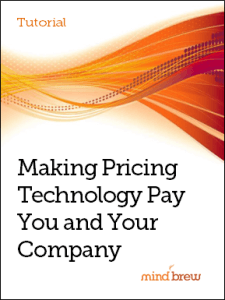It’s no secret that big data and price optimization tools based on machine learning are transforming the pricing profession. They allow businesses to create models and make forecasts in a fraction of the time that it took with older tools. And they enable companies to make calculations and work with data in ways that they were never able to before.
Given those realities, some pricing professionals have begun to worry that they might soon be out of a job.
Could the new technology become so powerful that it makes the pricing profession obsolete?
That idea is understandably frightening — if you aren’t old enough to remember the first introduction of electronic spreadsheets.
An article titled A Spreadsheet Way of Knowledge that was first published in 1984 does a good job of explaining just how revolutionary spreadsheet software was. And a lot of the language it uses is eerily similar to the descriptions of today’s machine learning-based tools.
Here’s an excerpt:
Today, VisiCalc and its newer rivals – most notably, a more powerful spreadsheet program designed by the Lotus Development Corporation called 1–2–3 – are making fundamental changes in the way American businesses work. For the first time, businessmen have at their fingertips sophisticated and flexible means to chart all the variables – from interest rates to warehouse space – that make (and break) businesses. The biggest firms, the most diversified corporations, can be neatly translated into spreadsheet “models” – each box of the grid a window on to once-overlooked facts or relationships. These models can be used not only to keep track of transactions but also to analyze the nature of a business itself. They allow businessmen to calculate the effects of sudden changes in the corporate environment (a decrease in the prime rate) and to experiment with scenarios (anything from the expansion of a product line to a merger) – all with an ease inconceivable five years ago. . . . .
There are corporate executives, wholesalers, retailers, and small business owners who talk about their business lives in two time periods: before and after the electronic spreadsheet. They cite prodigious gains in productivity. They speak of having a better handle on their businesses, of knowing more and planning better, of approaching their work more imaginatively.
Electronic spreadsheets allowed a single accountant to do the work formerly done by an entire team. That was a pretty scary prospect if you were an accountant in the 1980s.
But of course, with the benefit of hindsight, we know that spreadsheets did not make accountants obsolete. Just the opposite, in fact. Accountants used the time freed up by spreadsheets to do things with numbers that hadn’t been possible before. They became more valuable — not less — to their employees.
I believe the same thing is likely to happen with pricing. As the pricing tools become more powerful, pricing professionals who can use those tools in novel, strategic ways will become indispensable to the B2B firms that employ them.
One of my favorite sections from that old spreadsheet article is that part where the writer has to explain to the readers what a cursor is. He wrote, “The ‘cursor,’ a tiny block of light on the screen that acts like a kind of electronic pencil, can be moved (by a touch of the computer keyboard) to any cell on the spreadsheet.”
That kind of description seems laughably obvious to us today. In another decade or two the new-fangled algorithms and machine learning that writers have to painstakingly spell out today will very likely seem just as self-explanatory. If you want to be prepared for this future, the time is now to start using the emerging technology.
If you’re not sure where to begin, PricingBrew has a few resources to help. Check out Making Sense of Pricing Technology, Myth Vs. Reality in Pricing Technology, and Making Pricing Technology Pay You & Your Company.
In the long run, pricing technology probably won’t make you obsolete. But not learning to use the new pricing technology almost certainly will.
















